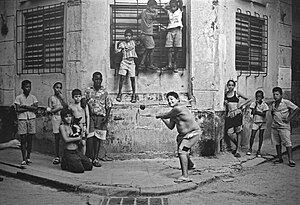Stickball

Stickball is a street game similar to baseball, usually formed as a pick-up game played in large cities in the Northeastern United States, especially New York City and Philadelphia.[1][2][3] The equipment consists of a broom handle and a rubber ball, typically a spaldeen,[4] pensy pinky, high bouncer or tennis ball.[1][2] The rules come from baseball and are modified to fit the situation. For example, a manhole cover may be used as a base, or buildings for foul lines.[1][2] The game is a variation of stick and ball games dating back to at least the 1750s. This game was widely popular among youths during the 20th century until the 1980s.
Variants[edit]

In fungo, the batter tosses the ball into the air and hits it on the way down or after one or more bounces.[5] Another variant is Vitilla, a popular variation of stickball played primarily in the Dominican Republic and areas in the United States with large Dominican populations.
Stickball in popular culture[edit]
- In a scene from the 1976 movie Rocky, a group of youths play halfball (a variant of stickball) on the streets of Philadelphia.[6] In the 1979 sequel Rocky II, the main character himself plays stickball/halfball in one scene.[7]
- The season 4 episode, "Lisa's First Word", of the animated series The Simpsons has a scene taking place in the Lower East Side of Springfield (visualized like a typical 1930s urban New York City neighborhood) where a boy says to his friends if they want to play stickball and they agree; instead of actually playing stickball, the group of kids head over to an arcade and play a video game of the sport.
- White Collar TV series (Episode 2.02 - "Need To Know") protagonist Neil Coffrey comes up with a clever plan to create a park in honor of the fictional boy Timmy Nolan, who loved to play the old-fashioned game of stickball.
Films[edit]
- Fast pitch Stick ball (An Unheard Pastime) (2007) Directed by Jesse Tornabe
- Coverage Of Stick ball Opening Day (2008)
- Bragging Rights: Stick ball Stories (2006). Directed by Sonia Gonzalez.
- Stick ball Night Coverage: Stick ball Highlights (2006). Directed by Ross O Fomerand.
See also[edit]
References[edit]
- ^ a b c Dandes, R. B. (May 5, 1985). "For These Boys of Summer, the Game Is Stickball". The New York Times. Retrieved July 2, 2024.
New York City was the hotbed of stickball interest. Devised in the 1920's, for many years the game was called One-Bounce. A pitcher would bounce a spaldeen - the little pink rubber ball that cost a nickel - to the plate. When it was hit with the sawed-off broomstick handle that served as a bat without being caught, the batter advanced to impromptu bases (sewers, for instance). [...] Stickball's popularity peaked in the 1950's. By the 60's, with the increasing number of cars that clogged city streets and the mass exodus to the suburbs, the game fell into decline.
{{cite news}}: CS1 maint: url-status (link) - ^ a b c Dupont, Kevin Paul (May 26, 2013). Written at New York City. "Stickball in New York is a vanishing game". The Boston Globe. Boston. Retrieved July 2, 2024.
What's more quintessential New York than stickball, right? Uh, no, not right. Stickball doesn't live here anymore. At least not in the way it does in the mind's eye, how it did when a young, vibrant Willie Mays swung a broom handle in the street outside his old home in Harlem in the 1950s or when Joe Pepitone did as a stylish Yankee in Brooklyn in the '60s.
- ^ Gold, Jonathan (September 11, 2017). "Welcome to Stickball Boulevard". ESPN. Retrieved July 2, 2024.
Stickball was once an integral part of the urban youth experience. Images of ragtag groups of children playing in the street became iconic depictions of New York City and helped shape the world's perception of New Yorkers as the street-smart, rough-and-tumble class of America. Slowly, like so much of Americana, it has faded from the streets, cars and buses rendering the roadways perilous, Xboxes and iPhones commandeering kids' attention.
- ^ Koerner, Brendan I. (March 13, 2005). "The Spaldeen Is Back (Even if the Dodgers Aren't)". The New York Times. Archived from the original on September 13, 2017. Retrieved February 18, 2017.
- ^ "Stickball Basics". Streetplay.com. Retrieved August 24, 2012.
- ^ "Rocky". www.awesomefilm.com. Retrieved 2022-08-27.
- ^ "1979 Topps Rocky II #3 Stickball Champ! | Trading Card Database". www.tcdb.com. Retrieved 2022-08-27.
